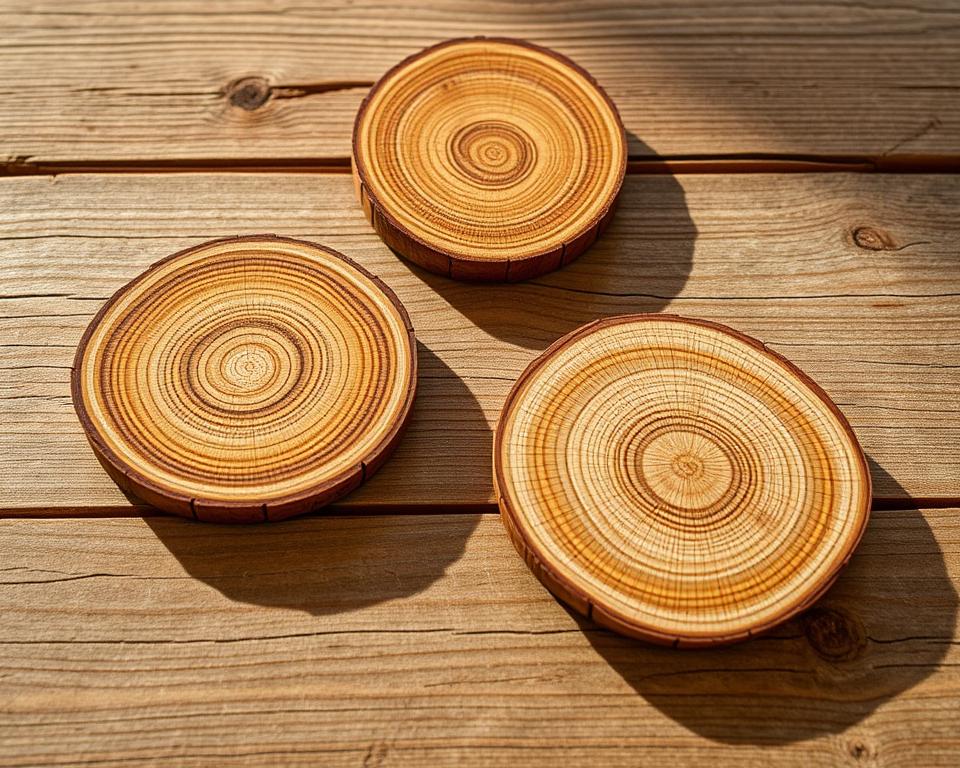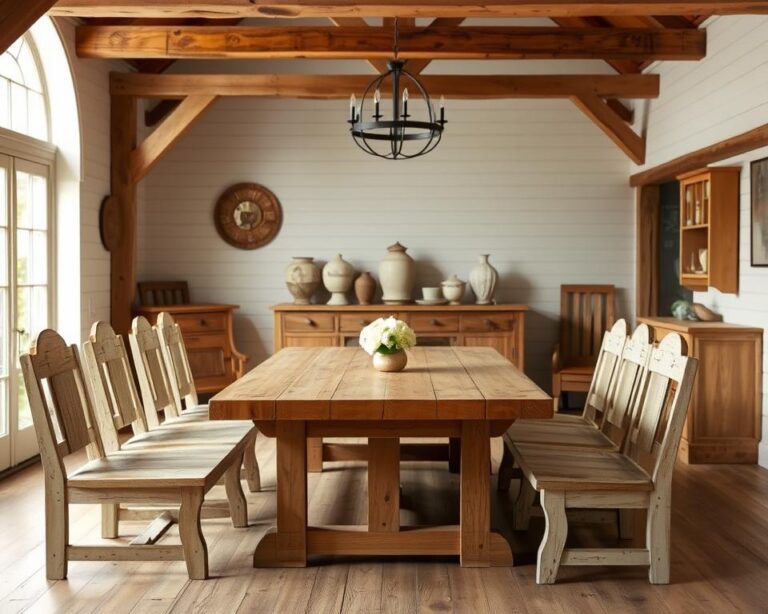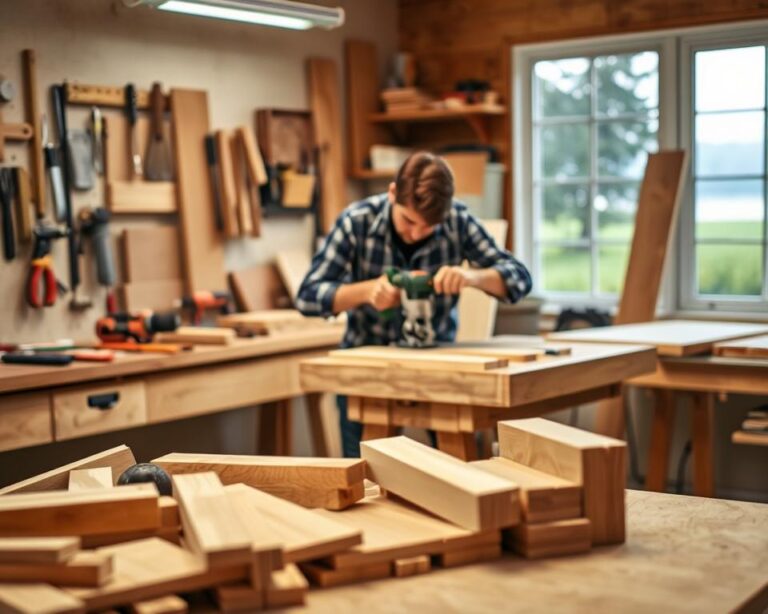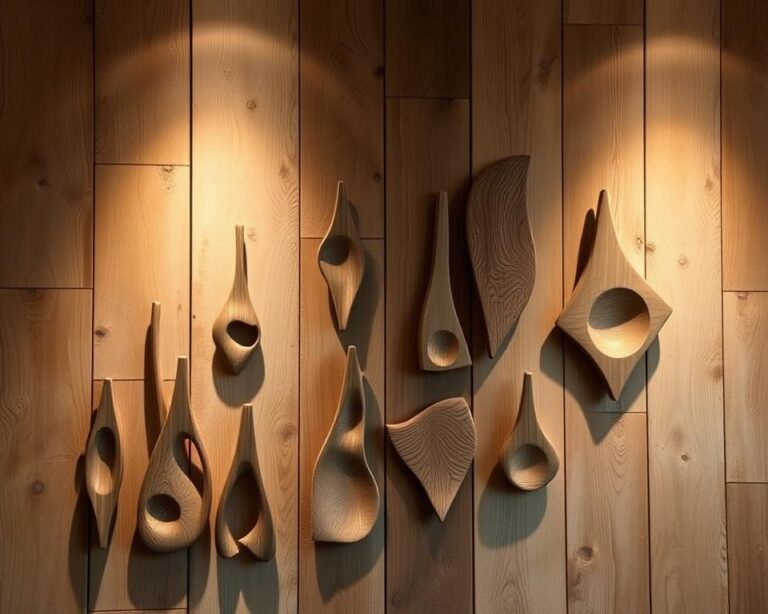Did you know the U.S. produces over 140 million tons of wood waste annually? You can turn those leftovers into lovely wood coasters. These simple DIY projects make not just useful coasters, but also add a special touch to your décor.
It doesn’t matter if you’re new to crafting or quite skilled. This easy wood coaster project is a great way to show off your creativity. At the same time, you help the environment.
Why Choose Wood Coasters for Your Home?
Wood coasters add charm and usefulness to any room. They’re not just nice to look at; they have practical perks too. When thinking about making wood coasters, knowing their good points helps you decide.
Benefits of Wooden Coasters
Wooden coasters last long and fit in with any decor. They keep ugly water marks and scratches off your tables. Just wipe them with a damp cloth to clean.
They’re tough enough for everyday use and still look great.
Aesthetic Appeal of Wood
Wood’s natural look and feel make any space warm. No matter if your home is rustic or modern, wood coasters match. They bring beauty and style to your tables and rooms.
Environmental Considerations
Choosing wood coasters, like those from reclaimed wood, shows you care about the planet. Using recycled materials cuts down waste and supports green habits. Picking wood coasters is good for the earth and makes your home look good.
Selecting the Right Type of Wood
Choosing the right wood is crucial for crafting wood coasters. The type selected impacts both look and durability. Exploring various wood types allows for creativity and showcases unique qualities.
Reclaimed Wood Options
Reclaimed wood makes for great coasters. It’s rich in history and has a unique look. Plus, using reclaimed wood reduces environmental impact and offers a charm that new wood doesn’t have.
Common Types of Wood for Coasters
Several woods are great for coasters:
- Oak: It’s strong, durable, and has a beautiful grain, perfect for elegant decor.
- Cedar: Cedar resists moisture well, making it a long-lasting choice for coasters.
- Pine: Pine is affordable, lightweight, and easy to handle, ideal for those just starting.
Tips for Choosing Quality Wood
Picking quality wood is key for lasting coasters. Here are some helpful tips:
- Check the wood’s moisture content; overly wet wood can split.
- Make sure the wood is pest-free to prevent weakening.
- Choose wood with straight grains for easier crafting.
Essential Tools for DIY Wood Coasters
To make beautiful wood coasters, you need some essential tools. Having the right tools improves your work and makes your coasters look perfect. Here are the main tools needed to create your coasters.
Cutting Tools You’ll Need
First, proper cutting tools help you cut your coasters to the right size. A miter saw is great for clean cuts. A circular saw works for bigger pieces. A jigsaw is good for detailed designs.
Sanding and Finishing Tools
After cutting, sanding smooths your coasters. A palm sander or orbital sander does the job quickly and evenly. You’ll need sandpaper from rough to smooth. For finishing, use wood varnish and clear sealers to protect the coasters and make them look nice.
Safety Gear to Consider
Working with wood requires safety gear. Always wear safety goggles for eye protection and a dust mask for your lungs. This safety gear lets you enjoy woodworking safely.
Step-by-Step Guide to Making Wooden Coasters
Making DIY wooden coasters is a fun project. This guide helps you through each step, so your coasters will reflect your style and meet your needs. First, prepare the wood, cut it into shapes, and smooth it out. This gives them both a good look and usefulness.
Preparing the Wood
Choose your favorite wood for the coasters. Check that it’s clean and free of moisture to avoid cracks. Clean off any dust with a damp cloth. Then, let the wood dry completely before cutting.
Cutting the Wood Pieces
Decide on the size of your coasters. A common size is 4.5 inches square. Carefully cut the wood with a saw, following your measurements. You might like rounded corners for a stylish look. Remember, being precise with your measurements and cuts is vital for nice coasters.
Sanding for a Smooth Finish
Sanding makes your coasters smooth and protects surfaces from scratches. Start with coarse sandpaper and then use finer grits. Make sure to smooth the edges too. A good sanding job turns simple coasters into lovely home additions.
Decorating Your Wood Coasters
Adding a personal touch to wood coasters can make your space feel more unique. There are many ways to turn simple coasters into artistic pieces. In this section, we’ll explore how to paint, stain, and personalize your wood coasters.
Painting Techniques
Painting coasters is an enjoyable way to show your creative side. You could use acrylic paints for bright colors or spray paints for a sleek look. Stenciling offers detailed designs, whereas freehand painting gives you creative freedom. Remember to seal your coasters to protect your designs.
Staining and Sealing Options
Staining is a fantastic method to highlight wood’s natural beauty. You can choose light stains to showcase the wood’s natural colors or dark stains for depth. Sealing is crucial to guard against damage and moisture, keeping your coasters in top condition.
Personalization Ideas
For a truly unique touch, personalization is the way to go. Wood burning can give coasters an individual flair. Adding a felt backing not only protects furniture but also adds to their functionality. With these ideas, your coasters can become truly one-of-a-kind.
| Technique | Description | Comments |
|---|---|---|
| Painting | Use acrylic or spray paint for vibrant colors. | Includes techniques like stenciling for intricate designs. |
| Staining | Enhances wood grain; options range from light to dark. | Seal to protect against moisture and wear. |
| Personalization | Use wood burning tools or add felt backs. | Creates unique coasters that reflect your personality. |
Caring for Your DIY Wooden Coasters
Keeping your DIY wooden coasters looking good and working well needs steady work. Taking care of them regularly means they’ll last longer and stay beautiful.
Cleaning Tips and Tricks
First, lightly dust your coasters with a microfiber cloth. Then, make a gentle soap and water mix for a deeper clean. Wipe them carefully without soaking to avoid damage. This method is key to keeping wood coasters clean and safe.
Proper Storage Methods
How you store your coasters greatly affects their condition. Keep them stacked in a dry place away from sunlight. Don’t put heavy items on them to prevent damage. Storing them correctly helps keep your coasters in top shape.
When to Refinish
Check your coasters now and then for scratches or dents. If you see these issues, it’s time for a new coat of sealant. Refinishing them often preserves their look and the wood’s beauty. This step is crucial for keeping your coasters in great condition over the years. For more care tips, check out this guide.
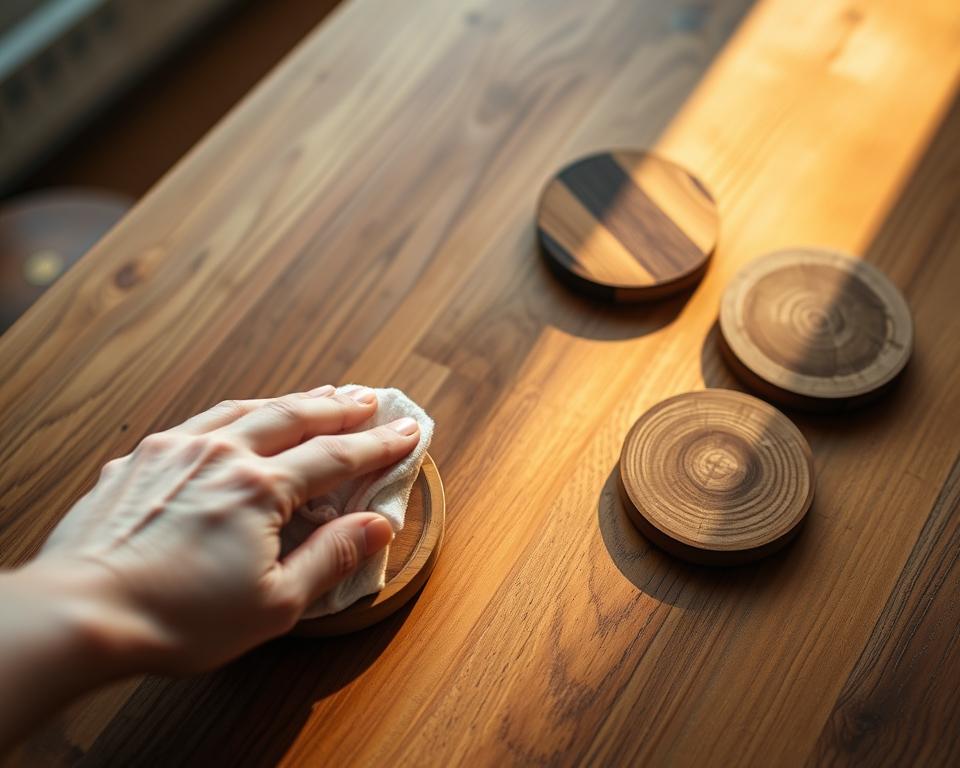
Creative Ideas for Custom Coasters
Exploring creative wood coaster ideas can spark your imagination. They bring a personal touch to your home décor. Custom coasters are not just useful; they can also be a charming addition to your space, reflecting your style and interests.
Themed Coaster Sets
Creating themed coaster sets can make everyday items special. For instance, coasters featuring nature scenes appeal to outdoor lovers. A sports-themed set might be just right for fans. You can even use family photos or inspirational quotes to make coasters unique, adding a personal touch to any gathering.
Coaster Art Projects for Kids
Coaster art projects are great for boosting kids’ creativity. With non-toxic paints or markers, they can decorate coasters with their favorite characters or designs. This activity not only improves their fine motor skills but also lets their imaginations soar. The result? Memorable gifts that enhance any home.
Functional Uses Beyond Drinks
Wooden coasters offer more uses than just holding drinks. They can be stylish bases for potted plants, giving your greenery a rustic look. Or turn them into decorative wall art. A simple arrangement of designed coasters can turn a wall into a stunning point of interest.
Where to Find Inspiration for Your Coaster Designs
Finding inspiration for coaster projects can make your creative journey more fun. You can look at various places that show off cool coaster designs and ideas. Here are some tips to kickstart your creativity and find resources to improve your projects.
Online Resources and Tutorials
Websites like Pinterest and many DIY blogs are great for coaster design resources. They offer lots of tutorials for all skill levels. It’s simple to find something that fits your style. These sites also share new techniques, patterns, and decoration ideas perfect for your wooden coasters.
DIY Workshops and Classes
Joining local workshops or classes lets you meet other crafters and learn by doing. Instructors share helpful tips to improve your skills. This setting boosts creativity and gives new inspiration, especially when working with other DIY fans.
Inspiration from Home Décor Stores
Visiting home décor stores can also give you coaster design ideas. These stores often have innovative products with exciting colors and materials. Looking at these can help you make coasters that fit your style and home.
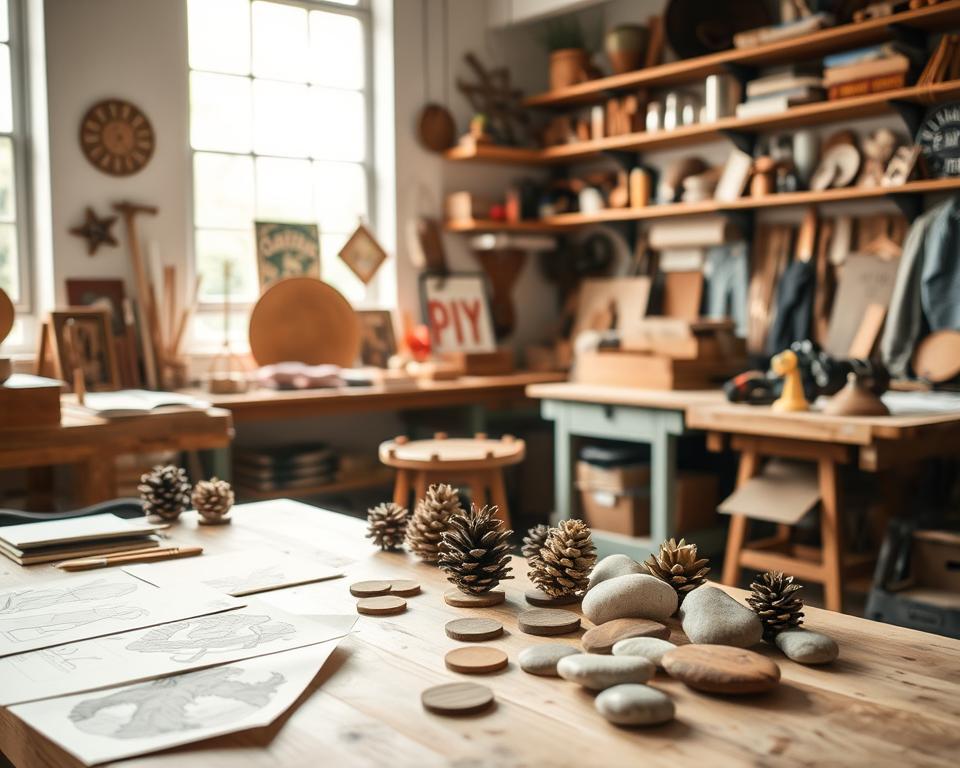
Joining a Community of DIY Enthusiasts
Joining a community of DIY lovers can make your woodworking path more exciting. No matter your skill level, chatting with others can offer new ideas and helpful tips. Places like online forums and social media groups are great to share projects, get advice, and meet people who love making things too.
Online Forums and Social Media Groups
Online forums for woodworkers are filled with tools and encouragement. Social media groups for DIY fans let you show off your projects and get praise. This can push you to try harder projects and play with different methods.
Local Craft Fairs and Meetups
Local craft fairs and meetups are perfect for meeting other DIY enthusiasts in person. These spots offer great chances to swap ideas, make friends, and even sell what you’ve made. Meeting people who also love crafting can inspire you and build lasting friends who share your interests.
Sharing Your Finished Projects
Don’t hesitate to post your DIY projects online! Putting pictures of your wooden coasters on Instagram or Pinterest can inspire people. It can also connect you with a group ready to start their DIY path. Sharing more leads to learning new skills that can improve your work.

